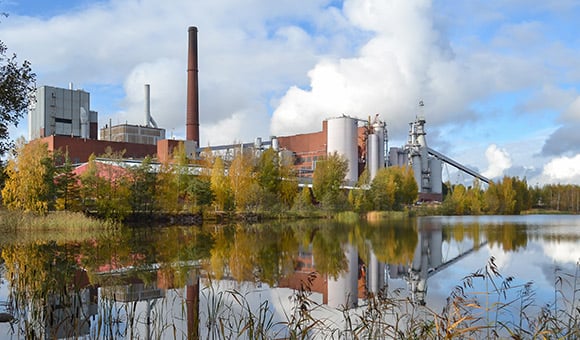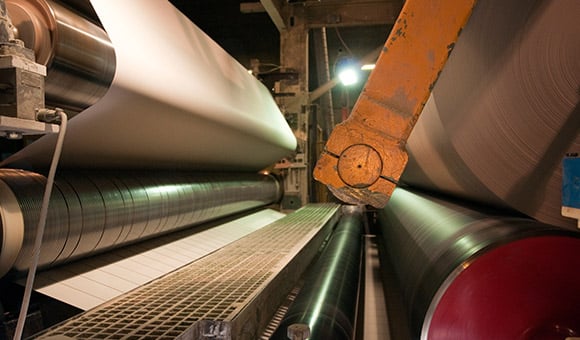Despite the shift to digital platforms, like this blog, for communications, paper remains an important resource and a growing industry. The global pulp and paper market is projected to grow from $351.51 billion in 2021 to $370.12 billion in 2028. Increased demand for paper and cardboard packaging is driving this projected growth.
This increased demand for packaging can be traced to two important societal trends. First, as companies adopt stricter sustainability goals, they are increasingly moving from plastic packaging to paper. This serves to reduce both plastic waste and the consumption of fossil fuels used in plastic production. Second, online sales remain high, fueling demand for paper packaging.
With these trends shaping the packaging paper and board industry and pressure to manage precious natural resources, it is essential that papermills installing new packaging machines or converting machines to new uses are designed and operated with both sustainability and efficiency in mind. Delays during machine start-up can cost thousands of dollars a day in lost production.
This blog will outline the steps in the start-up journey and highlight the services and support that a chemical supplier should provide to help mills accelerate their start-up timeline and avoid costly setbacks.
Planning and Design
Starting up packaging machines and getting them optimized for full capacity is an enormous challenge and a significant capital investment. It’s no wonder mills spend years planning — because paying attention to every detail ensures success.
Decisions made early in the planning process can ensure that appropriate applications and systems are designed and integrated from the ground up to avoid bolted-on solutions that may deliver suboptimal results. Your chemical supplier should provide a project manager who serves as the primary liaison between the supplier and mill staff. Ideally, this person would be an account manager who is already familiar with a mill’s layout and operations. And, for best results, this person should be supported by a team consisting of applications specialists, with detailed knowledge of chemistry systems, equipment specialists, with training in mechanical and electrical engineering, as well as employees with a strong pulp and papermaking background.
Collaboration during discovery and planning is important. In some cases, chemical providers will share insights and market data specific to the grades being considered, the chemical programs required, costs, and any energy or environmental components. In other cases, mills seek help from a provider after they have already made these assessments and decided to build a new machine or proceed with a conversion. In these situations, suppliers can prepare a full set of recommendations that addresses all machine-level considerations.
A System Approach
 In addition to knowing what chemical to feed, a mill must know where to feed it, how to feed it, and how to monitor and control the process in real time. It’s critical to take a total-system approach and to consider a comprehensive solution, from chemicals and equipment to installation and configuration. This ensures that the right systems are in place and that those systems will operate at required levels to deliver specified quality targets.
In addition to knowing what chemical to feed, a mill must know where to feed it, how to feed it, and how to monitor and control the process in real time. It’s critical to take a total-system approach and to consider a comprehensive solution, from chemicals and equipment to installation and configuration. This ensures that the right systems are in place and that those systems will operate at required levels to deliver specified quality targets.
Your chemical supplier should be able to design, procure, or supply a comprehensive chemical solution. This includes an appropriately sized and located chemical kitchen, as well as equipment packages ranging from simple dosing skids to sophisticated distributed skids that interface with the paper machine DCS system to deliver target dosages to multi-ply or multi-point applications. Your supplier should also have equipment expertise, with the ability to make recommendations for storage, makedown and delivery systems; injection and mixing systems; boiler treatment systems and clarification polymer makedown; and raw water and wastewater treatment makedown and delivery systems.
Comprehensive Evaluation During Start-up
 Maintaining and optimizing an existing chemical program is one thing. Designing and commissioning a high-performing program for a new machine, major rebuild, or grade conversion is entirely different. These types of projects require evaluating all systems, pilot testing proposed programs and ongoing optimization through the start-up phase.
Maintaining and optimizing an existing chemical program is one thing. Designing and commissioning a high-performing program for a new machine, major rebuild, or grade conversion is entirely different. These types of projects require evaluating all systems, pilot testing proposed programs and ongoing optimization through the start-up phase.
Testing and evaluation during start-up can identify opportunities for increasing productivity and quality. For example, microbial activity, scaling, and corrosion can have dramatic effects on paper machine production and end-product quality. It’s feasible to address these issues after a machine is up and running, but it’s better to catch them early. A mill could look to specify appropriate microbiological and deposit control technologies, defoamers, and cleaning products as part of the startup program so that they are ready for use if required. And, assessing the need for functional chemistries during start-up can ensure that the new asset meets the expected timeline and produces the target product quality.
In addition to process and functional chemistries, planning for mill water treatment must be considered during the start-up phase to limit the impact of increased production on water and energy consumption.
Monitoring and Modification
After a chemical program is established, continued monitoring is necessary to optimize performance and machine runnability. This involves evaluating overall program performance, tuning control systems, and modifying targets and control limits. Testing can last several weeks, or even months, but enables the start-up team to ensure that the programs are meeting performance standards and that production meets quality specifications.
A critical aspect of this phase is obtaining real-time assessments of the machine’s changing conditions. An automated monitoring and control solution is vital to accurately measure key performance indicators associated with important machine components, such as the Uhle box. Artificial intelligence is also emerging as an important tool for analyzing mill data and improving performance, so chemical suppliers that offer AI expertise can add tremendous value to their relationships with mills.
After the machine’s production has stabilized, ongoing support is necessary to check conditions, fine-tune machine settings, and document value delivery. The project team, including the project manager, account manager, and application specialists, should remain in close contact and provide a continuous interface with key mill personnel, including production managers, operators, and quality control analysts. As they work together, these stakeholders will monitor key indicators, including water and energy use and airborne and water emissions, to optimize the environmental performance of a start-up program and advance sustainability.
Complete Solutions from Solenis
Solenis specializes in packaging machine start-ups, and we understand the vast array of grades across the wide range of machine configurations that comprise this market segment. Because of our extensive experience and commitment to excellence, we have a proven track record helping mills accelerate their start-up curve with an advanced portfolio of products. Contact us today to learn how we can help with your packaging machine start-up or conversion project.